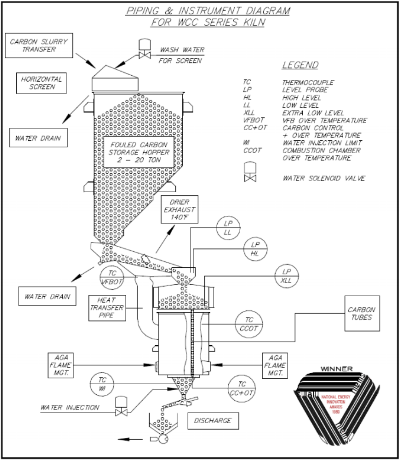WCC Carbon Reactivation Kilns
Our technology has overcome challenges that cause conventional rotary kilns to fail when operating in harsh environments. Decades of investing in research and development has ensured that our proprietary technology can resolve issues with saline water, organically fouled ores and tailings loaded with frothers and collecting agents. Our vertical kiln design overcomes the stresses associated with operating at high temperature and the presence of chloride ions by using a gravity feed system and eliminating rotating elements which are a major cause of stress failure in rotating kilns which are typically prone to stress corrosion cracking.
Technology Overview
WCC 50D - 50 kg/hr Dry Carbon Output
WCC 250D - 250 kg/hr Dry Carbon Output
WCC 500D - 500 kg/hr Dry Carbon Output
The WCC D series of Carbon Reactivation Kilns are suitable for the toughest gold mining environments and can handle conditions including saline water supplies, organically fouled open cuts and tailings loaded with frothers and collecting agents. The WCC Kiln is an indirect fired multiple tube vertical design. The `D' series come in three variants, which are able to process anything from 10 to 500 kg/h dry output, depending on the model. The founding company, Combustion Air has won multiple research awards, including a National Energy Innovation Award for the efficient use of energy. Peter Stewart founder of Combustion Air and now principle engineer has spent over 40 years investing and developing in the technology.
Major advantages
No moving parts and no stress on alloys at elevated temperatures or attrition of carbon.
Condensing flue at 60°C gives unmatched economy at 1.0 Kw/Kg (1550 Btu/lb) fuel consumption.
No oxidising gases in contact with carbon above 70°C.
Precise measurement and control of carbon temperature (not alloy or gases) gives consistent high activity.
Zoned furnace with no inclined or horizontal surfaces with carbon above 200°C giving excellent corrosion resistance.
Compact floor area.
Immediate start up without run through eliminates recycling.
Precise injection of water also allows immediate and effective dry screening of carbon at the kiln exit at a dry 250°C.
Carbon off screen at 120°C.
Technical Information
Drained, pre-dried carbon is fed from the VFB pre-drier to the choked kiln hopper. The product then moves gently through the kiln, as well as the setting of the discharge choke and vibratory feeder through the use of gravity (due to the vertical design). The temperature of the Carbon ranges from 70°C at the ambient exposed face to 100°C at the tube plate which is where the tube section begins. The removal of the remaining water vapour occurs at the top of the kiln tubes, resulting in an inert seal above and dry carbon for the temperature elevation.
In the first 1300mm of tube the carbon is raised from 100°C to 750°C, followed by the final 1000mm of tube operating at a temperatures of up to 800°C within the soak zone causing the gasification of pyrolytic residue through a controlled chemical reaction with water vapour. The bottom cone is injected with water in a controlled manner along with pyrolysis gases which enter the combustion chamber for integral incineration. The critical part of this process is the control of the temperature as well as the water injection, which leads to an effective reactivation, as seen in the WCC Kiln, which utilises a high turndown burner and temperature controlled water injection. The Carbon is then outputted from the Kiln at 250°C through the discharge nozzle and onto the vibratory screen. As the injection of water in the furnace zone vaporises and forms the inert atmosphere under which regeneration takes place; an effectively dry carbon screen allows granular flow immediately on kiln discharge.
The temperature at which reactivation occurs is specific to the situation. For example in circumstances with no flotation agents, frothers or organics such as tannic acids, reactivation to within 5% of new carbon can be achieved at 600°C. If the Carbon is fouled by organic agents this may require temperatures of up to 750°C to reactivate. Decades of technology investment has ensured our kiln technology can respond to your specific requirements and achieve optimal reactivation.


